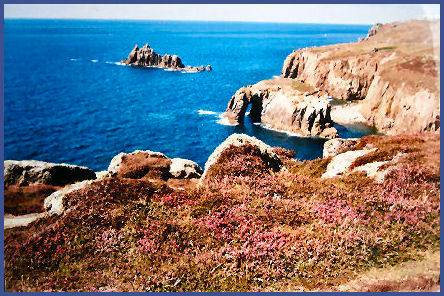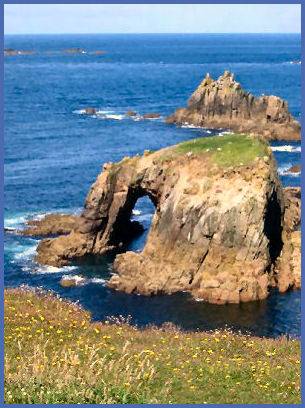Land's End

 Land's End, with its spectacular crashing waves
which lash the rugged Cornish cliffs, is the most westerly point in England and one of the most visited places in the county of Cornwall. The stunning scenery of Land's End has made it one of Britain's favourite destinations and one of the country's most magnificent and enduring landmarks.
Land's End, with its spectacular crashing waves
which lash the rugged Cornish cliffs, is the most westerly point in England and one of the most visited places in the county of Cornwall. The stunning scenery of Land's End has made it one of Britain's favourite destinations and one of the country's most magnificent and enduring landmarks.
Lands End has inspired people since the time of the ancient Greeks, it was known to the Romans as 'Belerion' meaning the sea of storms, while it is known in the Cornish language as Penn an Wlas or Pedn an Wlas, meaning 'the end of the earth'.
The stunning beauty of legendary Land's End is witness to the force of the Atlantic waves. The Longships Lighthouse stands solitary beyond the granite grandeur of the cliffs about a mile out to sea, the current lighthouse is the second tower to be built on the rocks and has been unmanned since 1967. Grey seals often bask there.
Further out to sea, about six miles to the south-west, the Wolf Rock lighthouse can be sighted. The famous dramatic arched rock formation is known as Enys Dodman.
On a clear day the Isles of Scilly are visible on the horizon, a beautiful group of islands of which five are inhabited. Although the Isles of Scilly are still part of the ceremonial county of Cornwall, and some services have been combined with those of Cornwall, since 1890 the islands have had a separate local authority.
Midway between Land's End and the Isles of Scilly is the supposed location of the mythical lost land of Lyonesse, an English
Atlantis, referred to in Arthurian literature. Legend clings to the stories of Lyonesse and sailor's tales report that the sound of ghostly bells
beneath the waves can sometimes be heard.
Land's End offers some of the most spectacular scenery in Cornwall, although visitors are advised that care must be exercised as some sections of the path traverse the high cliff edges.
A short walk along the cliff tops, which are strewn with a profusion of colourful wild flowers in the spring and summer months, offers unrivalled panoramic views and brings the visitor to Sennen Cove.
The Northern and Southern sections of South West Coastal Footpath meet at Lands End. The South West Coastal Footpath is the longest continuous footpath in Britain, traversing the coast for 630 miles from Minehead, on the edge of the Exmoor National Park, along the highly attractive coasts of Devon and Cornwall to Poole in Dorset.
The Land's End Centre is a tourist complex which features the history and heritage of Land's End and Cornwall, with particular emphasis on ships and the sea, and the hazards whichseamen have faced in the past. There are play areas for children, a suspension bridge, ships and helicopters. The centrepiece of the attraction is the Multi-Sensory Audio-Visual extravaganza of The Last Labyrinth, extending from the legends of King Arthur and the Lost Land of Lyonesse to the bravery of the Air-Sea rescue helicopter service - truly, an experience never to be forgotten. 'The Last Labyrinth' covers the local legends of King Arthur and the lost land of Lyonnesse.
There is also a discovery trail, RSPB hide, shops, a bar and restaurants.
On a small rise just inland of Land's End, St Breock Downs, stands the famous monolith of Table Men. The huge flat stone was the capstone of a now ruined Dark Age tomb, it is the largest and heaviest monolith in Cornwall, weighing in at about 16.5 tons, and probably dates to the Late Neolithic to mid-Bronze Age (around 2500–1500 BC).
Cornish legend states that King Arthur and four British Kings dined here before leading an army into battle against the ferocious Vikings in a battle known as Vellan Drucher. The heathland surrounding the St Breock Downs Monolith contains many other Bronze Age ritual monuments, with which the stone was probably associated.
Access is via the road from Penzance or the coast road from St. Ives.